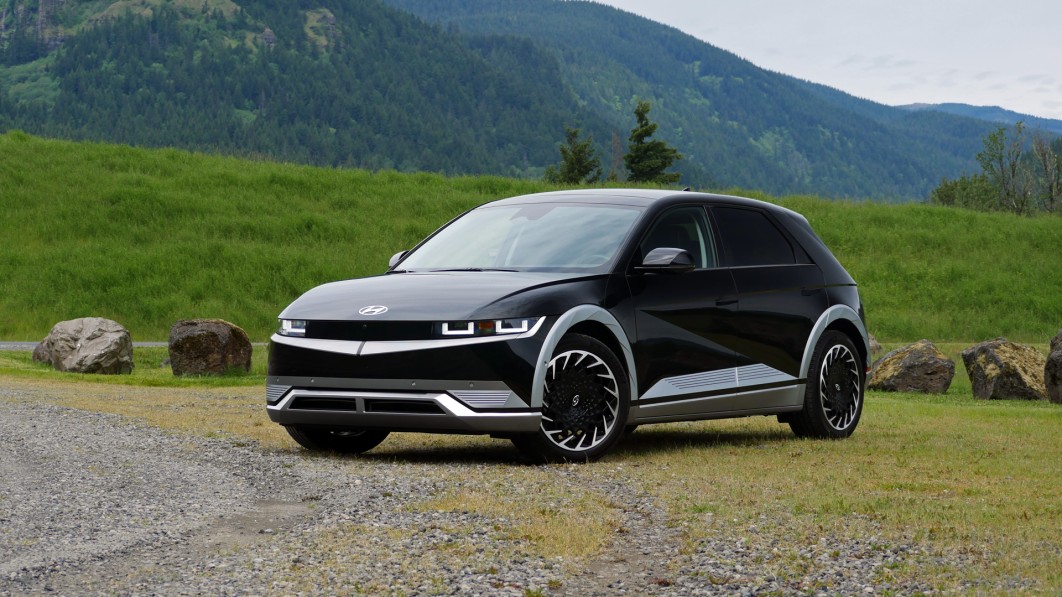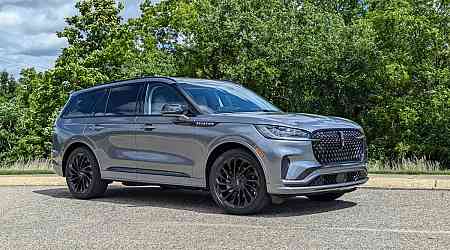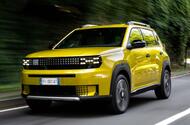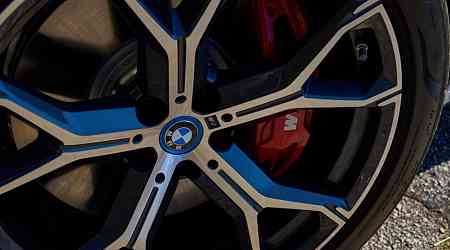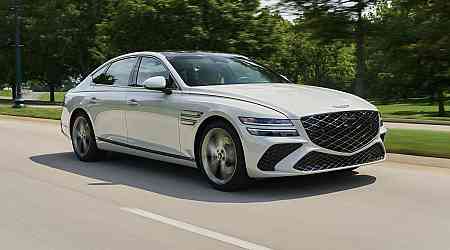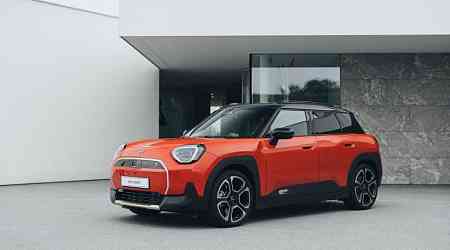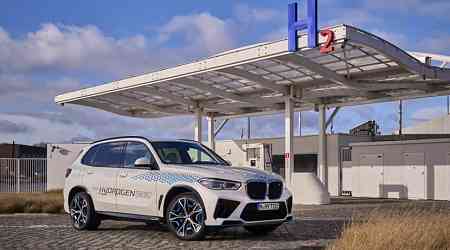Pros: Futuristic styling with utilitarian design; lengthy range; rapid charging; surprisingly fun to drive; excellent infotainment
Cons: Base model is less appealing; less useful cargo space than rival EVs; no federal tax credit
The electric car market is expanding and evolving rapidly, but the 2024 Hyundai Ioniq 5 continues to hover high above much of the field despite its nameplate being three years old. It still wows with its digitalized retro looks and hatchback shape that disguise the fact that it’s actually quite big. That size grants it a degree of practicality and comfort that make it a great family vehicle, while Hyundai has tuned it to be surprisingly fun to drive.
The Ioniq 5 checks plenty of other key boxes, especially for the typical EV buyers. Electric range is above average and its 800-volt architecture makes it one of the fastest-charging EVs, period. Performance is quite strong, too, especially with the dual-motor model. Infotainment tech is top-notch – it looks cool and is easy to use. Safety tech is even better – it’s one of the most extensive and best-executed driver assistance suites on the market.
As much as we love the Ioniq 5, checking out the mechanically related Kia EV6 and Hyundai Ioniq 6 sedan is a must, as is the new Chevrolet Blazer EV (although its availability is limited in the coming year). One also can’t ignore the low prices and superior charging network offered by the Tesla Model 3 and Model Y. We’re not sure any of them are quite as cool as the Ioniq 5, though.
Note that the refreshed 2025 Hyundai Ioniq 5 is coming soon, and the hi-po 2025 Hyundai Ioniq 5 N is available now. We're not totally sure what's in store for the rest of the next model year, but we've driven the 2025 Hyundai Ioniq 5 N (it's incredibly fun), and have included it in this buying guide.
Interior & Technology | Passenger & Cargo Space | Performance & Fuel Economy
What it's like to drive | Pricing & Trim Levels | Crash Ratings & Safety Features
What's new for 2024?
There are a slew of added standard features that weren’t available at all last year. This includes rear seat side airbags, rear outboard seatbelt pretensioners, steering wheel haptic feedback added to the lane-keeping and blind-spot warning systems, and in-car Wi-Fi capability (subscription required). A digital rearview mirror is also now standard on the Limited.
And finally, in case you’re wondering about the wild, high-performance Ioniq 5 N, it’s here as a 2025 model year. You can read our Hyundai Ioniq 5 N review here.



What are the Ioniq 5 interior and in-car technology like?
The Ioniq 5’s cabin is big, bright and airy, with a minimalist design aesthetic that doesn’t lose sight of functionality. Everything isn’t controlled and displayed on one screen, and there are still conventional buttons and switches for things like the windows and climate controls where you expect them to be. Even the touch-sensitive buttons and electronic shifter, which can typically be a source of frustration, are well-executed.
In the Limited trim, the center console is moveable, sliding forward and backward. That console is home to a pair of cupholders, a large cargo tray, a slot for a phone — with an available wireless charging pad — and a pair of USB ports. It’s a clean and calming space that’s surprisingly spacious and airy. The color palette is limited: black monotone and two-tone gray with a two-tone green sadly only available with the Digital Teal or Shooting Star exterior Limited trim levels.
Every Ioniq 5 features dual 12.3-inch displays, with one serving as the instrument panel, the other as an infotainment touchscreen. It’s one of the better infotainment systems on the market (it's also likely to be replaced with Hyundai's updated one, as the Ioniq 5 N has, and we don't like it as much). The menus make sense, simple tasks like changing a radio station are easy, responses are quick, and it looks good. We also like the 60/40-split screen functionality that lets you look at audio and navigation, for instance, at the same time. Unfortunately, wireless Apple CarPlay and Android Auto are not available, which obviously means you have to plug in your phone to use them. Worse, the data USB port is under the dash down by your shin (below right), meaning your phone will end up stranded down there, too. The non-data USB ports and the available wireless charger are located in the center console (below).
The Limited trim gets a head-up display with integrated augmented reality. In addition to the usual HUD duties, it can also project images to highlight the car ahead of you, give alerts about lane safety and help indicate where and when to make the next turn on your route. If that sounds like a lot of visual information, it is, but you can tailor the content shown in your HUD through menu selections. This is the type of cutting-edge tech you can only find in upper-crust vehicles like the Mercedes-Benz S-Class.


How big is the Ioniq 5?
It’s way bigger than it looks. While it looks like a hatchback in photos, seeing it in person, you can better understand why the Ioniq 5 is better classified as a midsize crossover SUV. Its wheelbase is about 3 inches longer than that of the three-row Hyundai Palisade. As such, the Ioniq 5 is fabulously roomy inside. Back seat legroom is vast, but then that’s pretty much an EV given at this point. The front row is especially spacious and open, however. The available sliding center console opens that lounge-like space up even more, and if you really want to lounge, the Limited includes a driver seat footrest to use while parked/charging (both pictured above).
As for the cargo area, the footprint is big, but the aggressively raked rear window means taller items could impede the closure of the liftgate. The rear seats can slide forward to allow a little more luggage space, at the expense of second-row passenger space. The Ioniq 5 claims 27.2 cubic feet behind the second row, which is lower than the Ford Mustang Mach-E’s 29.7 and the Volkswagen ID.4’s 30.3. Its on-paper volume is greater than that of its Kia EV6 cousin, but in our Ioniq 5 Luggage Test, we found that the shape/slope of the hatchback impedes loading, shrinks usable size and ultimately makes the cargo less spacious than the EV6 and the other electric crossovers. There’s no front trunk (or “frunk,” if you prefer) under the hood apart from a small space (0.85 cubic feet) only big enough to stash the mobile charging cable or other small items. That’s at least better than needing to store them in the cargo area, and at this point, few EVs have useful frunks.
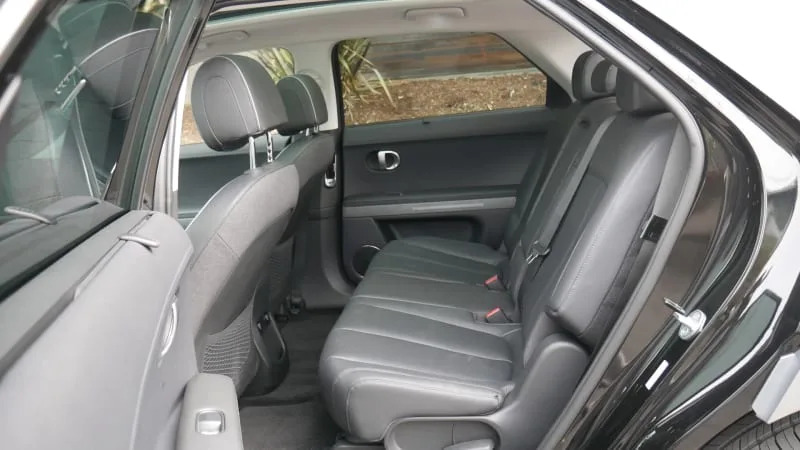



What are the Ioniq 5 fuel economy and range specs?
There are three drivetrain configurations for the Ioniq 5. The base standard-range version has a 58-kilowatt-hour battery good for 220 miles of driving. It is only available as a single-motor, rear-wheel-drive model with 168 horsepower and 258 pound-feet of torque. Its efficiency is rated at 110 miles-per-gallon-equivelent combined
Then there are two versions with the 77.4-kWh long-range battery. The single-motor rear-wheel-drive version provides 225 hp and 258 lb-ft of torque. That’s good enough for a sprint from 0-60 mph in around 7 seconds, which would be an average time for a midsize SUV. With a driving range of 303 miles, it’s rated at 110 mpg-e combined.
The all-wheel-drive version adds a second motor that powers the front wheels. The resulting total jumps significantly to 320 hp and 446 lb-ft of torque, which is why there’s a larger price premium for all-wheel drive than you’d see in gas-powered cars, plus the Toyota bZ4X and Chevrolet Blazer EV. All that extra juice motivates the Ioniq 5 from a stop to 60 mph in about 5 seconds, but range drops to a still useful 260 miles. It’s rated at 99 mpg-e combined.
On the charging front, the Ioniq 5’s 800-volt battery architecture means it can take advantage of 150- and 350-kW DC fast chargers, the latter able to take the battery from 10% up to 80% in just 18 minutes. It’s one of the fastest-charging EVs, period.
The 2025 Hyundai Ioniq 5 N gets dual-motor all-wheel drive good for 601 hp and 545 lb-ft of torque, or 641 hp and 568 lb-ft for 10 seconds at a time with the "N Grin Boost" function engaged. It'll do 0-60 in a claimed 3.25 seconds. Its 84-kWh battery has a range of 221 miles, and gets 72 mpg-e.
What's the Ioniq 5 like to drive?
Both the all-wheel-drive and RWD versions of the Ioniq 5 are an absolute delight, but the dual-motor AWD model is the one that'll get your heart pumping. With all the headline-generating, eye-popping 0-60 times of ultra EVs like the Tesla Model S Plaid, it's easy to forget that a 5-second 0-60 time is still awfully quick (and honestly, the long-range RWD model is far from slow at 7 seconds). The Ioniq 5's instant torque is enough to snap you back into your seat as you rocket onto the freeway. With Sport mode engaged, the AWD Ioniq 5 will treat you to a light but delectable serving of the rear wheels breaking traction to let the rear end peek out. It’s an addictive pleasure, and one that is sure to induce an endless supply of giggles.
That said, the Ioniq 5 can also be incredibly well behaved. Its long wheelbase makes for a calming sense of stability at highway speeds, while you’re quietly and comfortably whisked away to your destination. Hyundai’s Highway Driving Assist system includes adaptive cruise control (with machine learning to adapt to your driving style) and a very adept lane centering feature. The Highway Driving Assist II feature on the SEL and Limited trims gets semi-automated lane changes and integration with the augmented reality head-up display. There are also driving modes — Normal, Eco, Sport and Snow — to fit your mood or situation, and you can also dial in different amounts of regenerative braking force using the paddles on the back of the steering wheel. The highest level allows for one-pedal driving.
We have yet to test the single motor standard battery version, but its combination of range, performance and price make the Ioniq 5 less competitive.
As for the 2025 Ioniq 5 N, it's wild with tons of power and the ability to mimic engine noises and an eight-speed transmission. With N E-Shift, the Ioniq 5 doesn’t drive like an EV. The electric motors initially delay response to give the feeling of turbo lag. The power peaks and surges like the turbo engines in Hyundai’s other N cars. You can rev high in each gear and the Ioniq 5 will lurch and cut power while your fake tach needle bangs off the fake rev limiter. The experience is legitimately uncanny. And it’s fun. Like, a ton of fun. Masterful suspension tuning and powertrain trickery, plus an e-LSD at the rear, contribute to a car that happily flings itself amongst narrow, technical, back-and-forth esses. It feels big, but definitely not as big as its dimensions would suggest. The brake feel is firm and trusty by EV standards, but still not as sensitive on track as top ICE models. In a nod to committed left-foot brakers, the Hyundai allows a simultaneous two-step on the brake pedal and accelerator without cutting power.
What other Hyundai Ioniq 5 reviews can I read?
10 thoughts about the future-classic Hyundai Ioniq 5 N
Wildly fun and dripping with character, the high-powered N will be remembered.

Hyundai Ioniq 5 N First Drive Review: Mega fun everywhere, not just 0-60
We drive the U.S.-spec N. Every part of the EV SUV is retuned, from suspension and battery to seats and screens.

Comparison Test: Hyundai Ioniq 5 vs Ford Mustang Mach-E
Both are great, but which is better? We decide in this comparison test.

Hyundai Ioniq 5 Luggage Test: How much cargo space?
The electric hatchback/crossover has a weirdly shaped cargo area, but a handy sliding back seat.

Hyundai Ioniq 5 vs Kia EV6 Interior Comparison | Mellow modernism vs. supreme sportiness
Having trouble deciding between the Ioniq 5 or EV6? Our interior comparison could provide you the answer.

Hyundai Ioniq 5 Cupholder Mega Test
We check the cupholders and door pockets of the 2023 Hyundai Ioniq 5 to see if it will fit our favored but oversized water bottle.

2022 Hyundai Ioniq 5 First Drive Review | The electric hits keep coming
This is our first crack at the Ioniq 5, and we drive the top trim level with all-wheel drive in the city, on the highway and through some winding mountain roads. Let’s just say we’re in love.

What is the 2024 Hyundai Ioniq 5 price and where is it built?
The Ioniq 5 is built in South Korea, so it is ineligible for federal tax credits when purchasing the car. It may qualify for state credits, though, depending on your income level.
Pricing starts at $42,985, including the $1,395 destination charge, but that’s for the short-range, small-motor, rear-wheel-drive version. The bigger battery and more powerful rear motor start with the SE at $47,035. We think that’s the best place to start, and from there, the Ioniq 5’s trim levels are the usual ladder-type structure where each gets extra equipment plus additional style options.
All prices below include the $1,335 destination charge. And note that the atypically high all-wheel-drive price premium is the result of the dual-motor model adding significant performance in addition to all-weather traction.
- SE Standard-Range RWD: $43,195
- SE RWD: $47,245
- SE AWD: $50,745
- SEL RWD: $48,795
- SEL AWD: $52,295
- Limited RWD: $54,895
- Limited AWD: $58,795
- D100 Platinum Edition (Disney-themed): $61,795
The 2025 Hyundai Ioniq 5 N comes in a single trim with all-wheel drive, and costs $67,495, including the $1,395 destination charge.
What are the Ioniq 5 safety ratings and driver assistance features?
Every Ioniq 5 comes standard with forward automatic emergency braking with pedestrian and cyclist detection, lane-keeping assist, blind-spot and rear cross-traffic warning, Safe Exit Assist (uses the last two items to warn you against opening doors into cars or bicycles), a driver inattention warning system, rear occupant alert, rear parking sensors and adaptive cruise control with stop-and-go functionality and lane-centering steering assist. Rear side airbags are also standard, which is rare. Also available are surround-view parking camera, blind spot view monitor, front parking sensors, as well as the added functionality of Highway Driving Assist II (automated lane changes, and improved logic for adaptive cruise control to better adjust to cars cutting in front of you or encroaching on your lane). Besides simply having all these driver assistance features, it’s important to note how well-executed they are.
The 2024 Hyundai Ioniq 5 received an IIHS Top Safety Pick+ award, scoring the highest marks in every crash test category. Its base headlights scored an "Acceptable" rating, but the upgrade lights for the SEL and Limited scored the highest "Good" rating. The NHTSA gave the Ioniq 5 five out of five stars for overall, side and rollover crash protection. It got four stars for frontal crash protection.


















